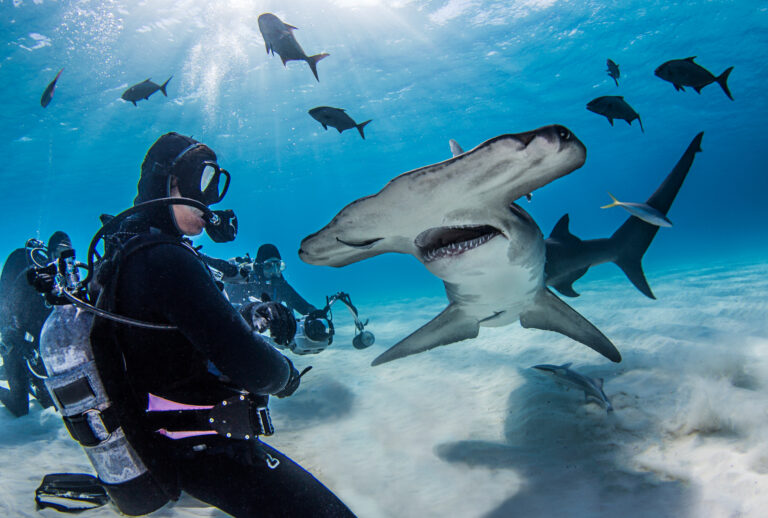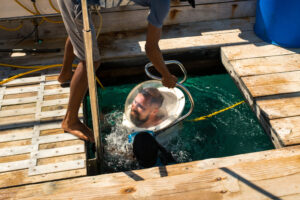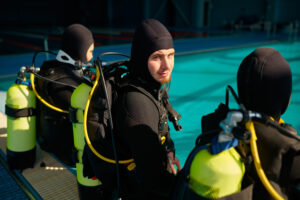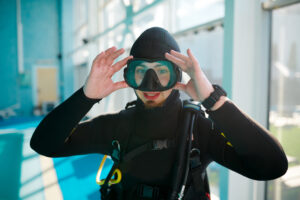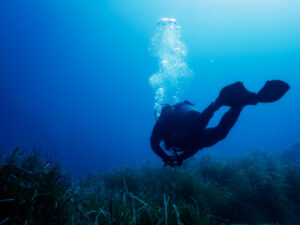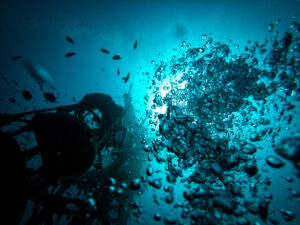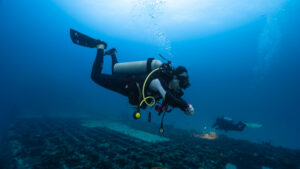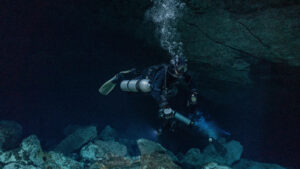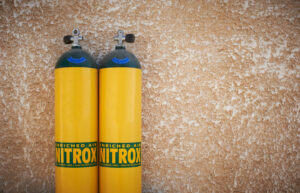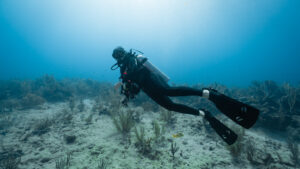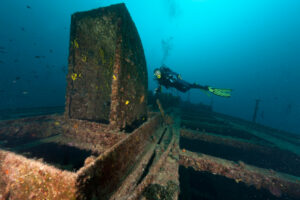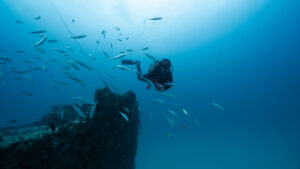What is a Glowstick?
A glowstick is a self-contained, short-term light source that produces light through a chemical reaction known as chemiluminescence. Originally developed for military and emergency use, glowsticks have become essential tools for various recreational activities, particularly in scuba diving. These devices are popular among divers for their ability to provide reliable illumination underwater, where traditional lighting options may be impractical or unsafe. Glowsticks are valued for their simplicity, durability, and the immediate bright light they emit, which can be critical for safety and communication during night dives or in low-visibility conditions.
History of Glowsticks
The history of glowsticks dates back to the 1960s, when scientists were exploring chemiluminescence for potential applications in emergency and military scenarios. The development was driven by the need for reliable light sources that did not rely on electricity or open flames. Early experiments focused on harnessing the light-producing reactions of chemicals such as luminol and oxalate esters. By the 1970s, these experiments led to the commercial production of glowsticks.
The U.S. military quickly adopted glowsticks for their advantages in low-light operations, particularly for signaling, marking locations, and providing light without compromising the soldiers’ positions. Their use extended to various branches of the military, including ground troops, naval operations, and air force personnel. The military’s reliance on glowsticks underscored their practicality and effectiveness in critical situations.
As glowstick technology evolved, it transitioned into the civilian sector. Outdoor enthusiasts, campers, and emergency responders recognized the benefits of portable, non-electric light sources. Glowsticks began appearing in safety kits, outdoor gear, and, notably, in the scuba diving community. Divers found glowsticks to be indispensable for night dives and underwater exploration, where traditional flashlights could be cumbersome or fail due to water pressure and other environmental factors.
Types of Glowsticks Used in Scuba Diving
In scuba diving, the choice of glowsticks varies depending on the type of dive and specific needs. Chemiluminescent glowsticks are the most common type, known for their reliability and ease of use. These glowsticks typically come in various sizes and colors, each suited to different underwater scenarios. The most popular sizes range from 4 to 12 inches, with larger sticks providing longer-lasting light. Colors like green, blue, and red are often chosen for their visibility underwater.
Battery-operated LED glowsticks have become increasingly popular due to their reusable nature and adjustable brightness levels. Unlike single-use chemiluminescent sticks, LED glowsticks can be recharged and used multiple times, making them a more sustainable option. These devices often feature multiple lighting modes, including steady, flashing, and SOS signals, offering versatility for divers in different situations.
Divers use glowsticks in various ways depending on the dive’s objectives. During night dives, glowsticks are attached to the diver’s gear or placed in strategic locations to mark entry and exit points. In cave diving, glowsticks can be used to illuminate tight spaces and guide divers through complex underwater passages. The choice between chemiluminescent and LED glowsticks often depends on personal preference and the specific requirements of the dive.
Importance in Scuba Diving
Glowsticks play a crucial role in ensuring diver safety and effective communication underwater. One of their primary uses is enhancing visibility in low-light conditions. During night dives or dives in murky waters, glowsticks provide a reliable source of light that can help divers see their surroundings and avoid hazards. This illumination is vital for maintaining situational awareness and preventing accidents.
In addition to providing light, glowsticks are essential tools for underwater communication. Divers use different colored glowsticks to convey specific signals or messages. For example, a green glowstick might indicate a safe path, while a red one could signal a warning or danger. By understanding these color codes, divers can communicate effectively without the need for verbal instructions, which can be challenging underwater due to the limitations of scuba gear.
Glowsticks are also used for navigation purposes. Divers often use them to mark entry and exit points, ensuring they can find their way back to the boat or shore. In more complex dives, such as cave diving, glowsticks can be placed along the route to guide divers through intricate passages. This practice is particularly important in environments where losing one’s way can have serious consequences.
Environmental Considerations
While glowsticks are valuable tools for divers, their environmental impact cannot be ignored. Disposable chemiluminescent glowsticks, in particular, contribute to marine pollution when not disposed of properly. The plastic casing and chemical components can become harmful debris, affecting marine life and ecosystems. When glowsticks are discarded in the ocean, they can break down into smaller particles that pose a threat to fish, sea turtles, and other marine animals.
To mitigate these environmental concerns, divers and manufacturers have been exploring more sustainable alternatives. One such alternative is the use of biodegradable glowsticks made from eco-friendly materials. These glowsticks are designed to break down more easily in the environment, reducing their long-term impact. Another solution is the increasing adoption of reusable LED glowsticks. While they require batteries, these devices can be used multiple times, significantly reducing waste.
Divers are also encouraged to follow best practices for disposing of used glowsticks. This includes bringing all used glowsticks back to the surface and disposing of them in designated waste bins. By being mindful of their environmental footprint, divers can continue to use glowsticks while minimizing their impact on marine ecosystems.
Technological Advancements
Technological advancements have significantly improved the performance and functionality of glowsticks for scuba diving. Traditional chemiluminescent glowsticks, while reliable, have seen improvements in brightness and duration. Modern chemistries allow these glowsticks to emit brighter light for extended periods, enhancing their utility for long dives.
The development of battery-operated LED glowsticks represents a major technological leap. These glowsticks offer adjustable brightness levels, multiple lighting modes, and longer lifespans compared to their chemiluminescent counterparts. LED technology has also enabled the creation of more compact and lightweight designs, making them easier to carry and use underwater.
Future trends in glowstick technology include the integration of smart features. Some manufacturers are experimenting with glowsticks that can be controlled via smartphone apps, allowing divers to adjust the lighting remotely. Other innovations focus on improving the environmental impact of glowsticks, such as developing new materials that are both durable and eco-friendly.
These advancements not only enhance the safety and experience of divers but also reflect a growing awareness of environmental sustainability. As technology continues to evolve, divers can expect even more innovative and efficient lighting solutions for their underwater adventures.
Practical Tips for Divers
Selecting and using glowsticks effectively requires some knowledge and preparation. When choosing glowsticks, divers should consider factors such as brightness, duration, and type of light. For night dives, brighter glowsticks with longer durations are preferable to ensure adequate visibility throughout the dive. In contrast, for marking entry points or specific locations, shorter and less bright glowsticks may suffice.
Proper positioning of glowsticks is essential for maximizing their effectiveness. Divers often attach glowsticks to their tanks, buoyancy control devices (BCDs), or wrists using lanyards or clips. This placement ensures that the light is always within the diver’s field of vision. When marking paths or locations, glowsticks should be placed at eye level or higher to be easily visible.
Safety precautions are also important when using glowsticks. Divers should carry multiple glowsticks to ensure they have a backup in case one fails. It’s also advisable to test glowsticks before the dive to confirm they are working properly. For LED glowsticks, checking battery levels and carrying spare batteries is crucial. Additionally, divers should be mindful of the environment and avoid leaving glowsticks behind after the dive.
Common mistakes to avoid include using expired glowsticks, which may not produce sufficient light, and over-relying on a single light source. Divers should always have multiple light sources, including a primary dive light, to ensure redundancy. By following these tips and best practices, divers can effectively use glowsticks to enhance their safety and enjoyment underwater.
Key Takeaways
Glowsticks are invaluable tools for scuba divers, providing essential illumination and communication in low-light conditions. While traditional chemiluminescent glowsticks are reliable, advancements in LED technology offer more sustainable and versatile options. Divers must consider environmental impacts and practice proper disposal of used glowsticks. By choosing the right type of glowstick and using them effectively, divers can enhance their underwater experience while minimizing their ecological footprint.

